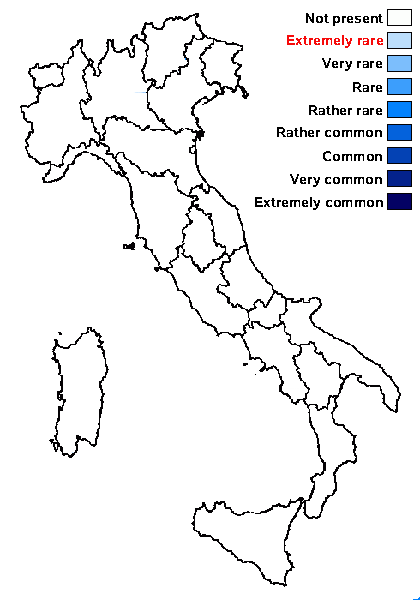Thelocarpon magnussonii G. Salisb.
North West. Nat.: 74, 1953
Synonyms:
Distribution:
Description: Thallus crustose, mostly reduced to small, scattered, 0.14-0.25 mm wide, hemispherical fruiting warts, almost colourless to brown-green when moist, pale brown to black-brown when dry, epruinose. Ascocarps frequent, perithecioid, fully immersed in the warts, with a concave, not exposed disc (the warts opening though a small pore). Exciple colourless, 15-18 μm thick, with a 20-35 μm thick algal sheath, without a pseudocortex, the algal cells reaching the surface; hymenial gel I+ red, K/I+ blue; paraphyses absent; periphyses sparingly branched, 6-10 μm long, arranged around the ostiole and on the sides. Asci many-spored, flask-shaped, tapering to apex, persistent, thin-walled, I-. Ascospores 1-celled, hyaline, oblong, thin-walled, slightly constricted in the middle, 3.5-4.5(-5) x 1.2-2 μm, often biguttulate. Photobiont chlorococcoid. Spot tests: K-, C-, KC-, P-. Chemistry: without lichen substances.Note: an easily overlooked, ephemeral, pioneer lichen found on disturbed substrata (small siliceous pebbles, bricks and roofing tiles, soil, even leather), mostly in humid-shaded situations, rare throughout Europe. To be looked for in Italy.
Growth form: Crustose
Substrata: rocks, soil, terricolous mosses, and plant debris
Photobiont: green algae other than Trentepohlia
Reproductive strategy: mainly sexual
Pioneer species

Predictive model
Growth form: Crustose
Substrata: rocks, soil, terricolous mosses, and plant debris
Photobiont: green algae other than Trentepohlia
Reproductive strategy: mainly sexual
Pioneer species

Predictive model
 INDEX FUNGORUM
INDEX FUNGORUM
 GBIF
GBIF

